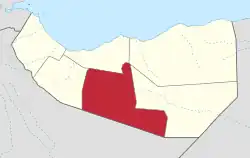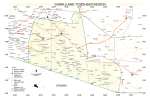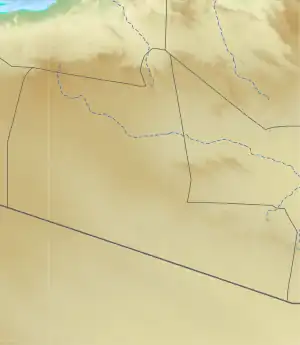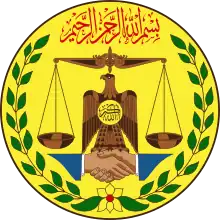Togdheer
| |
|---|---|
| Nickname: Gobolka Ragga (The Region of Men) | |
 Location in Somaliland | |
| Country | |
| Administrative centre | Burao |
| Government | |
| • Governor | Mahamed Abdillahi Ibrahim[1] |
| Area | |
| • Total | 30,426 km2 (11,748 sq mi) |
| Population (2013) | |
| • Total | 721,363 (estimate)[2] |
| Time zone | UTC+3 (EAT) |
| HDI (2021) | 0.323[3] low · 10th of 18 |
Togdheer (Somali: Togdheer, Arabic: تُوْجْدَيْر, romanized: Tūjdayr) is an administrative region (gobol) in central Somaliland. Togdheer is bordered by Maroodi Jeex to the west, Saaxil to the north, Sanaag to the northeast, Sool to the east and Ethiopia to the south. Its capital is Burao.[4][5]
Overview
Togdheer is bordered by Maroodi Jeex from the west, Sahil to the north, Ethiopia to the south, and Sanaag & Sool to the east. With its capital at Burao (Burco), the region's name is derived from the Togdheer River, which means "Long River" in Somali. The region has an approximate population of 350,000 people.[6]
Under British Somaliland, the Togdheer region was formerly the Burao district which was one of three districts that comprised the Burao region. The other two regions were Las Anod and Erigavo districts.[7] Sanaag was carved out of Togdheer region and was established as a separate region on June 23, 1973, comprising the three districts of Erigavo, Las Qorey and Garadag.[8]
As with much of Somaliland, most local residents in the Togdheer region are nomadic pastoralists.[9]
Districts
The Togdheer region consists of the following three districts:[10]
| District | Grade | Capital | Comments | Location |
|---|---|---|---|---|
| Burao | A | Burao | Regional capital | .svg.png.webp) |
| Oodweyne | B | Oodweyne | .svg.png.webp) | |
| Buhoodle | B | Buhoodle | .svg.png.webp) | |
Bal=Balanbaal, Blb=Balanbale, Bld=Balidhiig, Bla=Balli Ad, Be=Beer, Bee=Beerato, Bur=Burao, Buu=Buuhoodle, Ca=Cabdi Dheere, Ce=Ceegaag, Da=Dabaqabad, Ge=Gedobeh, Ha=Hahi, Haj=Haji Salah, Ho=Horufadhi, Is=Iskudar, Ja=Jaamac Liibaan, Ki=Kirit, Me=Megagle, Od=Odanleh, Oo=Oodweyne, Qa=Qalloocan, Qe=Qeedi Haan, Qoo=Qoorlugud, Qor=Qoryale, Sh=Shululux, So=Sool Joogto, Wa=Warabeye, Wi=Widhwidh, Yi=Yirowe
Demographics
It is primarily inhabited by the Habr Yonis, Habr Je'lo, Cabdale arab and the Issa Musa sub-divisions of the Habar Awal, all of which are subdivisions of the larger Isaaq clan.
The Dhulbahante of the Harti Darod clan is also present in the Buuhoodle district.[11][12]
Major towns
Map
- Map of Togdheer Region

See also
References
- ↑ "Somalia: President Bihi Announces Government Reshuffle". 11 September 2021.
- ↑ "Population Estimation Survey 2013" (PDF). Federal Republic of Somalia. Retrieved 21 November 2022.
- ↑ "Sub-national HDI - Area Database - Global Data Lab". hdi.globaldatalab.org. Retrieved 2018-09-13.
- ↑ Law, Gwillim (2015-09-01). "Regions of Somalia". Statoids.
- ↑ "Somalia". The World Factbook. Langley, Virginia, the USA: Central Intelligence Agency. Retrieved 6 December 2013.
- ↑ "Togdheer regional development plan (2014-2016)" (PDF). Republic of Somaliland Ministry of Planning and Development. Archived from the original (PDF) on 2020-10-13. Retrieved 2020-09-04.
- ↑ "Development map, roads, 1944". Library of Congress. Retrieved 2022-03-17.
- ↑ "Faafin rasmi ah ee Jumhuriyadda Dimuqradika Somaliya | CRL Digital Delivery System". ddsnext.crl.edu. Retrieved 2022-04-02.
- ↑ Bradbury, Mark (2008). Becoming Somaliland. Progressio. p. 201. ISBN 978-0-2533-5178-4.
- ↑ "Districts of Somalia". Statoids. Retrieved 6 December 2013.
- ↑ Hoehne, Markus V. (2010). Borders & Borderlands as resources in the Horn of Africa. p. 113. ISBN 9781847010186. Retrieved 14 November 2017.
- ↑ Gebrewold, Belachew (28 March 2013). Anatomy of Violence: Understanding the systems of conflict and violence in Africa. Ashgate Publishing Ltd. p. 130. ISBN 9781409499213. Retrieved 14 November 2017.
External links
- Administrative map of Togdheer
- Togdheer News Network (in Somali)

